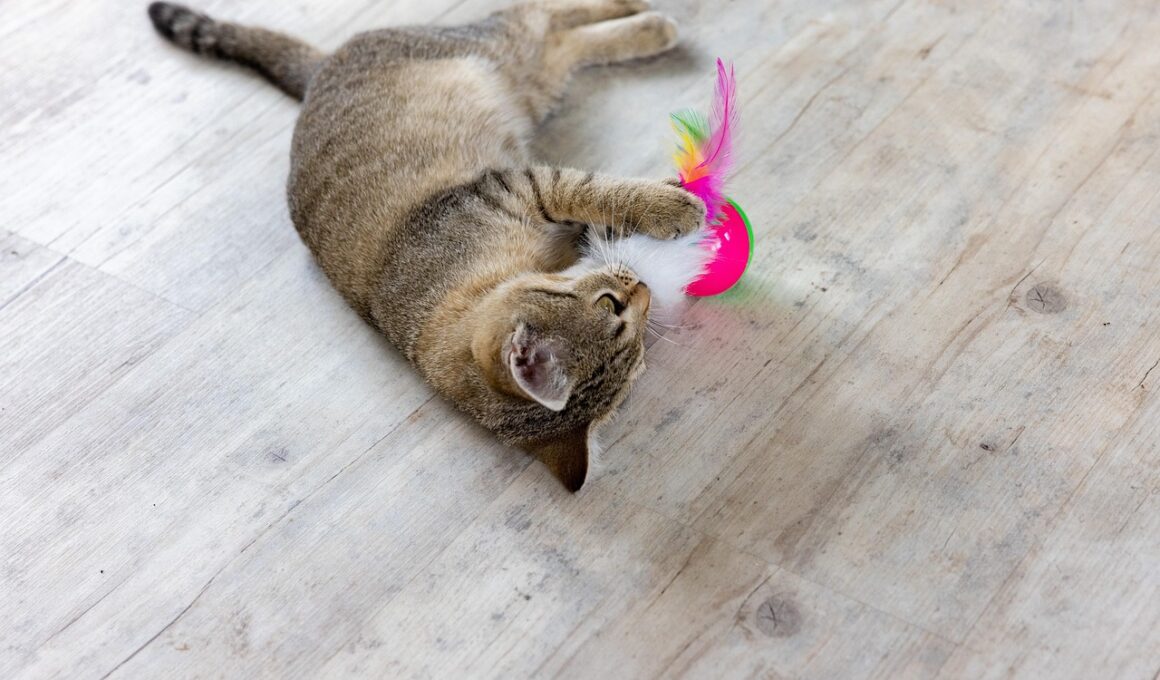The Importance of Social Play for Mental Stimulation in Cats
Social play is a vital activity for cats, significantly contributing to their mental stimulation and overall well-being. Engaging in play with other cats or humans allows them to develop essential social skills. This interaction mimics natural behavior seen in the wild, such as hunting and playing with littermates. Cats that regularly participate in social play are often more confident and less likely to exhibit behavioral problems. Moreover, the stimulation from social play helps counteract boredom, which can lead to anxiety and stress-related issues. Enrichment through interactive games, such as chasing toys or playing hide-and-seek, creates excitement in their lives. Cats become more physically active while developing better reflexes. Effective social play also involves varying the types of toys used, as variety prevents monotony and keeps the feline engaged. It’s essential to incorporate elements that tap into their predatory instincts. Feel free to explore online resources for new ideas. Always ensure that playtime is safe and enjoyable, giving your cat the opportunity to express its natural behavior in a controlled and welcoming environment.
Different types of social play can greatly benefit the shared space of pets and their owners. Group play, particularly among multiple cats, fosters cooperation and interaction among them. These sessions can be stimulating and can forge bonds of friendship that contribute positively to their lives. Such interactions prevent solitary behavior, which can lead to depression or anxiety among felines. Owners should observe their pets’ play styles; some cats prefer gentle nudges, while others may enjoy rough and tumble social play. Understanding these differences can enhance interactions and keep the cats engaged. Regular social play not only enhances physical fitness but also encourages the mental agility of the pets involved. Additionally, interactions with humans during playtime can strengthen the bond with the owner, leading to a happier living environment. Positive reinforcement during play, using treats or verbal praise, can encourage continued engagement. This relational aspect is crucial for maintaining emotional health in cats. Moreover, investing time in consistent play can mitigate any issues deriving from separation anxiety or territorial disputes among multiple cats. Playtime should be seen as a necessity in their daily routine rather than a luxury.
The Role of Interactive Toys
Interactive toys are a great addition when aiming to facilitate social play among cats. Such toys promote engagement and can be used for solo or group activities. For example, puzzle feeders encourage thinking and problem-solving skills, allowing pets to earn rewards for their efforts. These toys can also act as a focal point for social play. Cats love to work with each other to solve problems presented by these engaging toys. Offering toys that allow multiple participants can encourage teamwork and boost socializing behaviors, whether it’s a feather toy or a rolling ball. Moreover, interactive toys are beneficial in preventing obesity, as they foster physical movement through play. Integrated with social play, these toys create an environment where cats can safely express their instincts. Owners can also rotate the toys to keep the playtime fresh, preventing cats from becoming disinterested. Cat owners could research various interactive toys available on the market that suit their feline’s personality and interests. This variety is crucial for ongoing engagement and mental stimulation in cats, ensuring joy and healthfulness through the activities they undertake.
While engaging in social play is important, monitoring and facilitating healthy interactions is equally crucial. Supervision during play prevents injuries or aggressive behavior that might arise unexpectedly. All play sessions should be adjusted based on the energy levels and personalities of the cats involved. Sometimes, one cat might not appreciate an exuberant playmate’s energy, requiring adjustments to promote harmony. Owners should be attentive to any signs of withdrawal or stress, as this indicates a need for a break. It’s vital to observe body language closely; signs of discomfort can be displayed through hissing or tail movements. These cues are essential in understanding when the playtime should end or when to switch to a different activity. Social play should not be overly forced on any cat, which can lead to anxiety. Therefore, respecting boundaries during playtime will create a healthier space for interaction. Overall, promoting safe and enjoyable playtimes can cultivate a loving atmosphere where all pets in the household are at ease. It is beneficial for both mental and physical health, forging long-lasting, supportive relationships among the participants.
Establishing a Daily Routine
Incorporating social play into a cat’s daily routine enhances predictability and stability, essential for optimal mental health. Cats thrive on routine, so allocating specific times for play each day can set a framework for their day. Initially, determine what times of day are most active for your pets. Engaging them in consistent play during those peaks allows them to expend energy efficiently. This practice not only helps channel their instincts but also provides mental stimulation. Observing your cat’s responses is important; they often indicate preferences for particular activities. Incorporating various types of play—from laser pointers to feather chasers—ensures richness in stimulation. A varied routine can prevent ennui and encourage excitement during playtime. Making play an integral part of their daily life creates positive experiences your cats will look forward to. Regular socialization helps mitigate behavioral issues arising from boredom or loneliness, as regular interaction is crucial. Additionally, such routines present chances for bonding, where the owner becomes a pivotal figure in the cat’s life. Remember that consistency, combined with variety, is a surefire way to foster a healthy play culture in a household.
Having safe and stimulating environments for play is foundational for cats’ mental health. Designating play zones within the home can enhance both safety and accessibility. Interactive play areas that accommodate multiple cats should have sufficient space and safety features. Owners should remove any hazards that could potentially cause accidents during play sessions. Creative environments can include climbing structures or hideouts that cats can navigate through during play. Such setups encourage exploration, igniting curiosity and supporting their natural instincts. Setting up various stations fosters healthy competition and interaction among pets, making play more engaging. Additionally, cat trees or shelves offer perfect vantage points for observing surroundings while providing escapades when needed. Environments that maintain a balance between predictability and stimulation help form a happy, enriched household. Using materials that are safe and designed for feline use is paramount to their safety. Furthermore, adjusting elements in play environments over time guarantees interest persists. Understanding the preferences of your pets will help tailor the layout to fit their needs and desires, ultimately leading to more fulfilling interactions and stimulating play sessions.
Conclusion On Social Play
In conclusion, it is evident that social play is essential for mental stimulation in cats. Through nurturing a culture of play, pet owners can significantly improve their cat’s quality of life. The benefits of engaging in social play are vast, encompassing emotional bonding and behavioral stability. In addition to enhancing fun, social play opens pathways for exercising instincts and developing vital skills. Cats flourish in environments that showcase opportunities for interaction, building connections that reflect their natural instincts and desires. Consequently, incorporating social play into their daily routines should be a priority for responsible cat owners. Furthermore, choosing the right types of play and toys can create enhanced experiences, influencing the evolution of play’s role in a cat’s life. Monitoring and adjusting the play environment ensures that physical and emotional safety is upheld. Ultimately, cultivating healthy play practices promotes long-lasting relationships among pets and owners alike. Thus, the importance of playful interactions cannot be overstated; they shape the personality and well-being of cats, contributing significantly to joyous and fulfilling life experiences. Fostering this aspect of cat care can yield lasting happiness.
Social play is a vital activity for cats, significantly contributing to their mental stimulation and overall well-being. Engaging in play with other cats or humans allows them to develop essential social skills.


